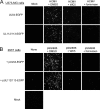The 6-aminoquinolone WC5 inhibits human cytomegalovirus replication at an early stage by interfering with the transactivating activity of viral immediate-early 2 protein
- PMID: 20194695
- PMCID: PMC2863603
- DOI: 10.1128/AAC.01730-09
The 6-aminoquinolone WC5 inhibits human cytomegalovirus replication at an early stage by interfering with the transactivating activity of viral immediate-early 2 protein
Abstract
WC5 is a 6-aminoquinolone that potently inhibits the replication of human cytomegalovirus (HCMV) but has no activity, or significantly less activity, against other herpesviruses. Here we investigated the nature of its specific anti-HCMV activity. Structure-activity relationship studies on a small series of analogues showed that WC5 possesses the most suitable pattern of substitutions around the quinolone scaffold to give potent and selective anti-HCMV activity. Studies performed to identify the possible target of WC5 indicated that it prevents viral DNA synthesis but does not significantly affect DNA polymerase activity. In yield reduction experiments with different multiplicities of infection, the anti-HCMV activity of WC5 appeared to be highly dependent on the viral inoculum, suggesting that WC5 may act at an initial stage of virus replication. Consistently, time-of-addition and time-of-removal studies demonstrated that WC5 affects a phase of the HCMV replicative cycle that precedes viral DNA synthesis. Experiments to monitor the effects of the compound on virus attachment and entry showed that it does not inhibit either process. Evaluation of viral mRNA and protein expression revealed that WC5 targets an event of the HCMV replicative cycle that follows the transcription and translation of immediate-early genes and precedes those of early and late genes. In cell-based assays to test the effects of WC5 on the transactivating activity of the HCMV immediate-early 2 (IE2) protein, WC5 markedly interfered with IE2-mediated transactivation of viral early promoters. Finally, WC5 combined with ganciclovir in checkerboard experiments exhibited highly synergistic activity. These findings suggest that WC5 deserves further investigation as a candidate anti-HCMV drug with a novel mechanism of action.
Figures








Similar articles
-
Bright and Early: Inhibiting Human Cytomegalovirus by Targeting Major Immediate-Early Gene Expression or Protein Function.Viruses. 2020 Jan 16;12(1):110. doi: 10.3390/v12010110. Viruses. 2020. PMID: 31963209 Free PMC article. Review.
-
The 6-Aminoquinolone WC5 inhibits different functions of the immediate-early 2 (IE2) protein of human cytomegalovirus that are essential for viral replication.Antimicrob Agents Chemother. 2014 Nov;58(11):6615-26. doi: 10.1128/AAC.03309-14. Epub 2014 Aug 25. Antimicrob Agents Chemother. 2014. PMID: 25155603 Free PMC article.
-
Design, synthesis, and evaluation of WC5 analogues as inhibitors of human cytomegalovirus Immediate-Early 2 protein, a promising target for anti-HCMV treatment.ChemMedChem. 2013 Aug;8(8):1403-14. doi: 10.1002/cmdc.201300106. Epub 2013 Jun 11. ChemMedChem. 2013. PMID: 23757191
-
The isoquinoline alkaloid berberine inhibits human cytomegalovirus replication by interfering with the viral Immediate Early-2 (IE2) protein transactivating activity.Antiviral Res. 2019 Apr;164:52-60. doi: 10.1016/j.antiviral.2019.02.006. Epub 2019 Feb 8. Antiviral Res. 2019. PMID: 30738836
-
Inhibition of cytomegalovirus immediate early gene expression: a therapeutic option?Antiviral Res. 2001 Mar;49(3):129-45. doi: 10.1016/s0166-3542(01)00126-7. Antiviral Res. 2001. PMID: 11428240 Review.
Cited by
-
Sulfated derivatives of Escherichia coli K5 capsular polysaccharide are potent inhibitors of human cytomegalovirus.Antimicrob Agents Chemother. 2010 Nov;54(11):4561-7. doi: 10.1128/AAC.00721-10. Epub 2010 Aug 16. Antimicrob Agents Chemother. 2010. PMID: 20713657 Free PMC article.
-
The Clinically Approved Antifungal Drug Posaconazole Inhibits Human Cytomegalovirus Replication.Antimicrob Agents Chemother. 2020 Sep 21;64(10):e00056-20. doi: 10.1128/AAC.00056-20. Print 2020 Sep 21. Antimicrob Agents Chemother. 2020. PMID: 32690644 Free PMC article.
-
Human Cytomegalovirus IE2 Both Activates and Represses Initiation and Modulates Elongation in a Context-Dependent Manner.mBio. 2022 Jun 28;13(3):e0033722. doi: 10.1128/mbio.00337-22. Epub 2022 May 17. mBio. 2022. PMID: 35579393 Free PMC article.
-
Bright and Early: Inhibiting Human Cytomegalovirus by Targeting Major Immediate-Early Gene Expression or Protein Function.Viruses. 2020 Jan 16;12(1):110. doi: 10.3390/v12010110. Viruses. 2020. PMID: 31963209 Free PMC article. Review.
-
Promising Schiff bases in antiviral drug design and discovery.Med Chem Res. 2023;32(6):1063-1076. doi: 10.1007/s00044-023-03068-0. Epub 2023 May 10. Med Chem Res. 2023. PMID: 37305208 Free PMC article. Review.
References
-
- Andrei, G., E. De Clercq, and R. Snoeck. 2008. Novel inhibitors of human CMV. Curr. Opin. Investig. Drugs 9:132-145. - PubMed
-
- Andriole, V. T. 1988. The quinolones. Academic Press, London, United Kingdom.
-
- Asmar, J., L. Wiebusch, M. Truss, and C. Hagemeier. 2004. The putative zinc finger of the human cytomegalovirus IE2 86-kilodalton protein is dispensable for DNA binding and autorepression, thereby demarcating a concise core domain in the C terminus of the protein. J. Virol. 78:11853-11864. - PMC - PubMed
-
- Biron, K. K., J. A. Fyfe, S. C. Stanat, L. K. Leslie, J. B. Sorrell, C. U. Lambe, and D. M. Coen. 1986. A human cytomegalovirus mutant resistant to the nucleoside analog 9-([2-hydroxy-1-(hydroxymethyl)ethoxy]methyl)guanine (BW B759U) induces reduced levels of BW B759U triphosphate. Proc. Natl. Acad. Sci. U. S. A. 83:8769-8773. - PMC - PubMed
Publication types
MeSH terms
Substances
LinkOut - more resources
Full Text Sources
Other Literature Sources
Medical

